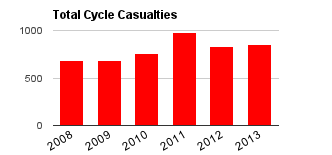For the second year running Portsmouth is the most dangerous place in England outside of London. Government statistics show that Portsmouth suffered 832 cyclist casualties per million population in 2012.
This is despite a very welcome improvement from the terrible figure of 983 per million, in 2011.
On Portsmouth’s roads, over the last 5 years, 157 cyclists have been killed or severely injured. When you include pedestrian road casualties, 318 vulnerable road users (VRU) were killed or severely injured, with a total 1,408 casualties.
And 316 of these were children under 16 - making up nearly a quarter of VRU casualties in Portsmouth.
PCC’s own surveys in schools and workplaces, said:
’ the main barriers to cycling are concerns about the volume and speed of traffic, personal safety, lack of continuous cycle lanes or safe cycle routes, …’ and: ‘there is an issue around volume of traffic and the behaviour of a proportion of drivers in the city, and this can often make people feel vulnerable and lacking in the confidence to ride on the roads.’ and: ‘It is mainly women who say that lack of confidence on the roads is a major reason why they don’t cycle/cycle more’. One example of this was Lynne Stagg, Lord Mayor and formerly Cabinet Member for Traffic and Transportation, who said in 2010: “I don’t cycle any more. The roads aren’t safe.”

In Portsmouth, with the worst cycling casualty figures outside London and a widespread fear of cycling for safety reasons, fewer than 5% cycle to work - unchanged for a decade.
In Copenhagen, which prioritises works to make cyclists safe, 36% commuted by bike, including children travelling to school.
Where do accidents happen?
DfT’s figures show that cyclists are four times more likely to be casualties on Urban A roads than on Urban Other roads.
This is due to the lethal effect of the higher speed on A roads, creating a toxic mix of two-way motor traffic, cyclists and pedestrians - including, of course, children and the elderly.
Then add in parked cars, bus stops, multiple side roads, major junctions, rush hours and the dropping off and picking up of children at school - all on Portsmouth’s narrow and congested streets.
Portsmouth’s road accident figures show this is a recipe for mayhem and it’s the vulnerable road users who are paying the price - with terrible consequences for families, friends and colleagues - years after the initial accident.
What can be done?
Last year, when the 2011 figures came out, a PCC spokesperson said:
‘…we are the most densely-populated area outside central London. As cyclists are more likely to have accidents on busy urban streets, this might also have an impact on our figures.’ Portsmouth Cycle Forum says this is no excuse. For safety, the Department for Transport (DfT) recommends applying a user hierarchy to the road design process with pedestrians at the top.
Clearly, vulnerable road users need protection from the lethal speed and weight of cars, vans, buses and lorries, often passing them just a hair’s breadth away.
One distraction; an unexpected event, and a cyclist or pedestrian is put at risk - we’ve all seen it happen, day after day.
When they are protected - as Copenhagen shows - many more people choose to walk and cycle and accident rates plummet.
The bottom line is that sections of Portsmouth’s A road network are just too narrow to safely accommodate the volume and mix of today’s traffic. A change must be made if we are to stop these casualties.
In A Cycling Strategy for Portsmouth: Draft for Consultation, in 2009, PCC endorsed the DfT road user hierarchy approach, giving priority to pedestrians and cyclists.
Isn’t it about time this was put into practice on Portsmouth’s Urban A roads - to stop us having the worst casualty rate outside London for another year?
